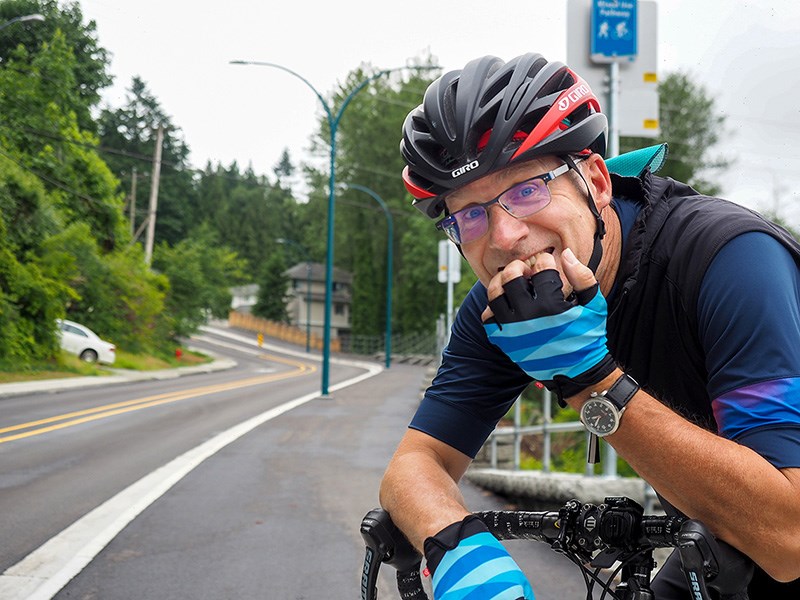It’s one thing to build a multi-use path, quite another to get walkers and cyclists to use it.
Port Moody accomplished the former with its $4.627-million upgrade of Gatensbury Road to make the steep, winding connector between it and the city and Coquitlam safer for motorists and add a $285,000 multi-use path (MUP) along its western flank for pedestrians and people on bikes.
The project was identified as an early priority in Port Moody’s master transportation plan, which was endorsed by council in March 2017. That plan will see the city invest more than $31 million over the next 20 years to make it easier to get around the city, and encourage more sustainable modes of transportation, like walking and cycling.
Ascending Gatensbury, though, remains a test of fortitude, leg strength and lung capacity.
Already the climb to the top has been dubbed the “Gatensbury Gasp” on social media by some pedestrians who have scaled its 12% average pitch over 1.1 kilometres since it reopened to traffic at the end of May.
But what does that mean for cyclists?
Always up for a good bike story, I set out to find out.
I’m not a climber. Descending is more my jam.
I ride up hills and mountains because I have to get to the top so I can turn around and speed back down.
For the most part, cyclists have avoided Gatensbury for years because of its narrow lanes that lacked a shoulder and its pocked pavement that made it unsafe at worst, uncomfortable at best.
Oh yeah, there's also its perilous steepness, which ranges from 11.1% at the bottom to 18.3% in its final rise.
By comparison, Mont Ventoux, one of the iconic climbs of the Tour de France, peaks at 12% and the Muur van Geraardsbergen in Belgium, that has been a decisive climb in big-time professional bike races like the Tour of Flanders, rises an average of 9.3% over its 1,075 metres over bumpy, tire-eating cobbles that can rattle the fillings from your teeth.
The pavement on Gatensbury’s new MUP is smooth tarmac, not yet heaved by straying tree roots or ravaged by winter freezes and thaws.
The path is also wide — maybe not wide enough to allow teetering cyclists to weave their own switchbacks to stay upright, but certainly wide enough for pedestrians and riders to pass each other easily.
According to Strava, an online app that allows cyclists and runners to upload data from their GPS devices, 43 cyclists have completed the segment called “Todds Gatensbury climb,” which is .94 km from the base of the hill at Henry and Grant streets to Bartlett Avenue at the top, this year. The fastest was Matthew Cox, a Port Moody cyclist who made it to the top in four minutes, four seconds. That’s an average speed of 13.9 km/h and well off the all-time record of 17.7 km/h by Brett Wakefield back in 2015, when the road was in much worse shape and there was no MUP. Some notable athletes have also tackled Gatensbury, including Canadian Olympic triathlete Simon Whitfield — he did it in 3:49 in 2013.
At the start of the MUP, after a warmup pedal from The Tri-City News’ office in Port Coquitlam, I could only dream of such blinding uphill speed. In fact, I just wanted to survive without my knees, or heart, exploding.
The climbing starts at a modest 3.9% at Henry and Moody streets but by the time it hits its first switchback, it touches 17%. It’s about then I realize I’m still in second gear. I veer into a driveway to change gears because doing so under high torque in a difficult climb can blow apart a derailleur.
The second switchback is consistently around 15% but goes as steep as 18.2%.
But the nastiness is just getting started.
Looking ahead, the road straightens, the gradient moderates slightly and the end seems in sight. The bike computer says I’m doing 6.6 km/h but, gasping for breath and rocking side-to-side, it feels like I’m standing still.
Then, the road veers left to reveal its cruellest twist: more climbing, some of it is as steep as 17.3%.
I reach Bartlett Avenue 7:09 after I started the climb, the 25th-fastest — or 18th slowest — ascent of the segment recorded on Strava so far this year.
As I cross Gatensbury to collect my reward — a speedy descent on the road's smooth, new pavement — a cyclist on an electric-assist bike with fat, cushy tires, cruises nonchalantly by on the uphill side. He’s smiling, with barely a bead of sweat on his brow.
Maybe he has the right idea.



